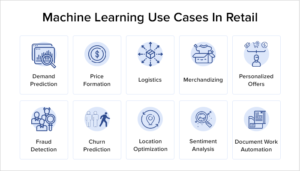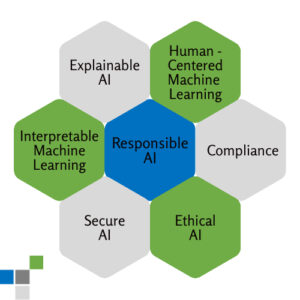Machine learning in retail can be as simple as the self-checkout line, the computer kiosks, or the virtual shopping assistants. It helps facilitate existing customers while pulling in new customers.
What is Machine Learning?
Machine learning takes large pieces of data and breaks them apart into key insights. It allows producers to take a look into demand, price, and customer behavior. It effectively predicts outcomes for the optimization of profits, creates a better
 understanding of customers’ behaviors and allows you to create new product discoveries. This flourishes your ability to topple other competitors. For more information on Machine Learning visit Machine Learning – A Practical Guide.
understanding of customers’ behaviors and allows you to create new product discoveries. This flourishes your ability to topple other competitors. For more information on Machine Learning visit Machine Learning – A Practical Guide.
ML Use Cases
- Pricing strategy, Dynamic pricing and pricing optimization
The way you price an item can pull customers in or out. By using machine learning, it can help improve your pricing strategy. When a price is determined by one person, it is often different from the value held by another. Give a plant, for example, a nature aficionado may value it to be 10 dollars while you price it at 2. This is why this type of pricing can lead to inefficient results.
By using ML, it takes in data that consistently prices an item over and over again. It takes into account historical trends, present trends, and current behaviors to create the optimal price: for example like the brand, the fabric, the condition, etc. It even compares multiple vendors’ pricing against the market price to deliver the best deals. The amount you price your goods determines the profit you will make. ML takes in all economic variables to make a pricing strategy. By looking at how long a customer looks at a product, what products they buy, and what they browse through, ML prices the product efficiently. It even has a randomness function. Say the price has no variability, ML will change the price accordingly to see the profits and inputs of the decision. By analyzing the sales you get at every price point, ML can become smarter and make better price decisions for your company.
- Product Matching
Product matching is when ML links similar items together. This is especially beneficial when you are comparing prices with competitors or have similar products. Since most customers compare prices before they buy, it is especially important that businesses utilize ML to track their competitor’s prices. When you have a larger catalog of prices, it may be harder to organize all of them and match them. ML can look through the attributes of each item such as its picture, description, and price to match them. If we take Target, for example, the website has many different products of just black jackets. But a typical algorithm will often not match them together. Why is this? Because typical algorithms do not have the strength or data managing capabilities ML has.
- Target Market Optimization
Marketing is a core value in any business. You need to market to get your product out there and known. ML can crack into consumers’ social media and e-commerce platforms to get key metrics: age, gender, interests, persona, state, city, and time on site. Once the ML takes in these metrics it analyzes how they work together and it creates a relationship between the two. With this connection, it will personalize the ad toward the consumer. For example, say you were on social media looking at photos of sushi, ML can see that and connect an ad to that specific interest. This can make sure the target market is reached and the business seeks maximum profits.
- Prediction for Inventory Management
Retailers need to know how much inventory they need to keep, buy or sell. ML will take a deep dive into the current atmosphere: special holidays, seasons, social media, etc. From that it will provide you with ideas for how much inventory you will need. For example, say you sell chocolates and valentine’s day is approaching, well ML will use the event to predict the inventory for that period. Additionally, by looking at past data ML can show when the inventory may be out of stock again. This way a business can let their consumers know without having the problem of insufficient supply.
- Fraud detection
In terms of businesses, it is always important to be safe from danger. Just like we humans get insurance, our technology needs fraud detection. ML allows you to take a deeper dive into missing items, suspicious activity, missing patterns, and weird behavior. Since ML looks at these trends when there is a spike in an account or a pattern it can warn you of suspicious activity.
- Video surveillance and analytics
Having video surveillance is important to notice any stolen items, broken goods, or suspicious activity. When ML is used in accordance with surveillance, it can analyze the material and make note of suspicious patterns. This highly intricate machine can take into account minute differences that can make or break a business. As humans, we cannot see everything in a video. We may misinterpret something or completely look over it. This isn’t the case with ML. It relies on visual data to make sense of distinct eccentric patterns.
- Recommendation engines
ML allows businesses to give a more personalized outlook on their products. It analyzes the type of customer it is dealing with and connects he/she with a product they like. By looking into personal data, patterns, purchases, and browsing history, ML connects the consumer with products they would like. This allows customers to get more recommendations for their interests which can help businesses raise profits.
With all that being said, Data Ninjas can help customers who are looking to implement Artificial Intelligence and Machine Learning solutions in their company. There are many benefits businesses can achieve implementing Machine learning solutions, from pricing strategy to product matching. Data Ninjas can help work through those processes and deliver amazing results. To contact Data Ninjas for your business needs visit https://yourdataninjas.com/contact/.

